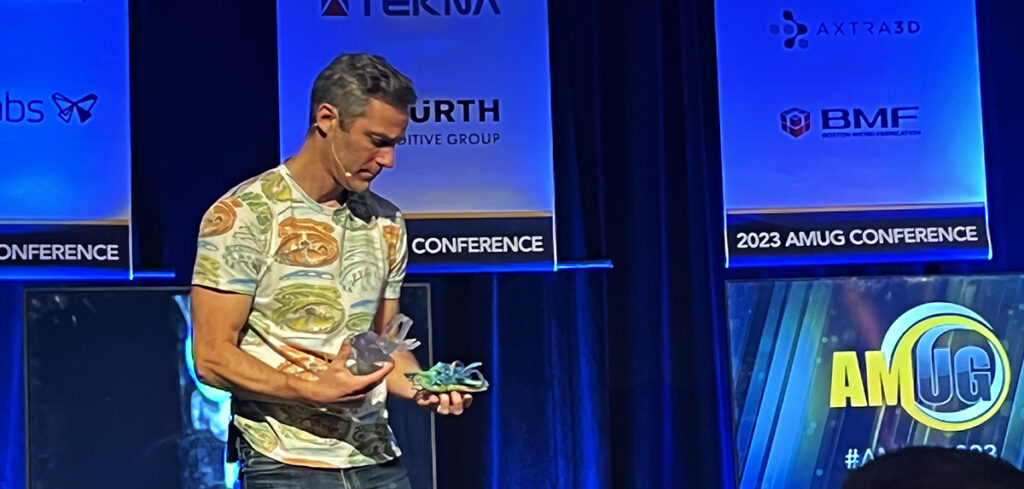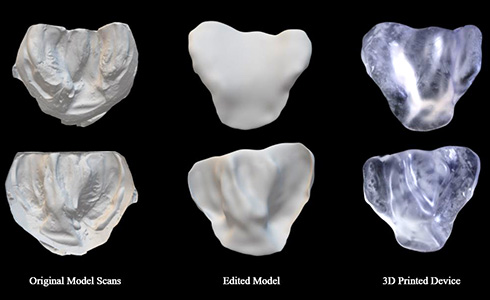In reading our series on the early days of the Additive Manufacturing Users Group (AMUG), attendees of the 2023 AMUG Conference may be blown away by the sheer growth of the organization and the industry as a whole. What began as the SLA Users Conference in 1989, with just 50 attendees from 25 companies has grown to over 2,000 participants, 650 of whom were first-time attendees. Altogether, this year’s event demonstrated a new level of maturity of for the 3D printing industry.

The great gesticulator, Todd Grimm.
Attendees flew in as early as Sunday, with many staying throughout the duration of the nearly week-long event. The show was packed to the brim with activities, both on-site and off-. This included a Sunday tour of Illinois-based Impossible Objects, the annual surprise dinner, and numerous hands-on workshops and panels. Those that see AMUG as a “their vacation” for the year, were able to let loose at Chicago’s renowned Museum of Science and Industry and the show’s Steampunk Casino Night.
The Exhibit Floor
Mondays are the key day for the exhibit hall and are the most commercial aspect of the event, as selling products are neither allowed in room presentations or from casual briefcases encounters. This frees attendees up to what is meant to be pure education and networking for the remainder of the show—though high level sponsors are able to maintain booths for the rest of the week. For those of us that use exhibitions as a primary method of education, this means trying to absorb as much as possible from the booths as possible on this first full day of the event.
Among the firms I was able to connect with was 1000 Kelvin, whose CEO, Omar Fergani, I met at Additive Manufacturing Strategies 2023, but whose technology I was only able to familiarize myself with at AMUG. The German startup applies machine learning to metal laser powder bed fusion (LPBF) to ensure first-time right 3D printing.
The print environment on LPBF equipment is so complex that any number of variables can cause a print to fail. This includes cracking, residual stresses, and fatigue that not only leads to a waste of material, time and money, but can even damage the printer if a recoater crashes into the failed part. Historically, it’s been necessary to print parts anywhere from seven to 12 times, at least, to achieve the proper design, orientation, and support structures for a successful print. This is only complicated when shooting for mass production because the physics of the process even depend on where in the build chamber the part is made.
Because users typically need to print a metal part using costly materials on expensive equipment numerous times before achieving a successful component, first-time right printing has been an objective of machine manufacturers and users at least since GE began exploring its famed 3D printed fuel nozzle. 1000 Kelvin’s software, AMAIZE, actually predicts and corrects issues in a print so that engineers don’t have to modify their designs to obtain a successful outcome.
Fergani pointed to a number of examples, from heat exchangers for military craft to pressure vessels for the German space agency. According to the CEO, the firm’s cloud-based software performs its analysis and repairs quickly, automatically, and with no training.
“It is done fully automatically because the machine learning algorithms that we have developed are trained and validated. Now, the work is done on backend. When we develop our machine learning, that’s where we have our manufacturing. We have a few machines where we train these algorithms, where we validate them,” Fergani said.
The company is currently in the learning and implementation phase, with a number of customers, some of whom will be publicly named in the near future. As it finds more users who are applying the technology to production environments, 1000 Kelvin will be able to learn from the process even further, thus improving the capabilities of its software that much more.
Blending Animation and Computational Modeling for Medical 3D Printing
The first keynote of the show was a poignant one, showcasing both how far the industry had come in its almost four decades of existence and how AMUG itself is facilitating that growth. Given by 3D printing animation pioneer Rob Ducey, of LAIKA Studios, and Nicholas Jacobson, Colorado University Anschutz Medical Campus. The duo explained how, upon meeting at AMUG in 2019, they were able to develop a fruitful relationship around a shared use of Stratasys PolyJet technology for their respective fields.
While Ducey has long pushed the boundaries of PolyJet to create vibrant puppets for such works as Missing Link, Jacobson has applied AM to everything from architecture to fashion. However, it was medical 3D printing that brought the two together. First 3D printing models for surgical planning, the two have been able to impact patient outcomes more and more directly.

They have applied computational modeling and materials development to bring about new medical tools with PolyJet, deciphering the proper voxel-level tuning to achieve the exact models necessary to inform physicians in their treatment of patients with complex, often rare illnesses. Case studies included removing brain tumors, repairing congenital heart defects, and diagnosing epilepsy.
One of their most recent projects have seen Ducey and Jacobson develop patient specific devices for children born with cleft palates. Jacobson described their nasoalveolar molding (NAM) tool as “Invisalign for cleft palates,” in that they could potentially be used to sculpt an infant’s lip region in an incremental manner based on CT scans. Because there are so few clinics dedicated to treating this issue, the NAM device could be delivered directly to patients’ local doctors or even at home. Ducey applied his history with modeling characters’ faces to adjusting patient scans in a similarly precise fashion.

“Invisalign for cleft palates.” Image courtesy of CU Anschutz.
“What we realized is that the level of detail, control, and the precision that they were needing and the scales that they were working in were exactly the same as our [animated character] faces and we’re very concerned with how things fit,” Ducey said. “We have to fit within a very tight tolerance and we have to be able to manipulate the geometry in very small increments in order to build performance. So, we have already had a set of tools that could be applied to this exact problem [of cleft palates] and we also know how to print the thing. What Nick and I are trying to figure out is a way to build a system that can, in some ways, automate this manual process that these expert clinicians know how to do and be able to export it to places where those clinicians are unavailable.”

This demonstrated that the pair could develop 3D printed devices for use externally, leading them to the logical next step, 3D printed implants. Nicholson and Ducey are now looking at the ability to design 3D printed heart valves with unique microstructures capable of rapid cellular integration.
3D Printing Workshops and Panels
For those who get starstruck by the industry’s inventors, it was possible to rub elbows with Stratasys founder Scott Crump as he applied his expertise in material extrusion to hand-squeezed cement in the “Concrete Rheology for Additive Manufacturing” workshop from Oak Ridge National Laboratory.
As a member of the press, it often feels unfair for me to take up a spot in the hands-on workshops, as those skills should be provided directly to the industry’s inventors. However, such topics as “Foundry in a Box” seem almost too informative to pass up next year. After all, metal casting may be a key skill when it comes to 3D printing for preppers.
I was able to benefit from such presentations as “Various Applications and Associated Lessons Learned for Unmanned Aerial Systems for Defense,” in which General Atomic Aeronautical Systems Inc. and Divergent Technologies revealed exactly how the latter’s unique robotic assembly technique is performed. In a talk from Jim Wise, Production Program Manager of Midwest Prototyping, and Carlos Zwikker, COO of AM-Flow, I got a glimpse into how an AM service bureau can begin automating its operations to improve efficiency and reduce manual labor.

Zwikker explained that AM-Flow grew out of the needs of his 3D printing service business, which began to quantify every cost related to the company. His team determined that cost per part is essentially determined by materials, depreciation of printers, and labor. Over time, the firm was able to reduce the first two costs by writing off AM equipment over time and negotiating better material prices, but that labor was not coming down in anyway. For that reason, AM-Flow has developed automation solutions for steps throughout the production workflow that significantly cut the amount of human intervention required.
“You have to start thinking it is no longer necessary to work in the way that you have been working,” Zwikker said. “We’re not going to take away jobs in that sense, but we are going to take away the boring jobs of identifying, walking around with parts cetera. We can automate that, but we need to understand that automation perspective of what is the requirement of the production environment.”
The pair highlighted how, regardless of how standard AM production environments become, they will still be different from one another simply through the additive nature of the manufacturing process. Automation through technologies like those offered by AM-Flow will help to address that variability, as well.
More to Come
For such a packed event, it is impossible to capture everything about AMUG. However, in subsequent articles, we will be able to showcase some individual companies we spoke to, including EOS, Materialise, Impossible Objects and more. We were also able to learn about specific trends occurring in AM that may be difficult to suss out without a macro lens.
Subscribe to Our Email Newsletter
Stay up-to-date on all the latest news from the 3D printing industry and receive information and offers from third party vendors.
You May Also Like
Further Understanding of 3D Printing Design at ADDITIV Design World
ADDITIV is back once again! This time, the virtual platform for additive manufacturing will be holding the first-ever edition of ADDITIV Design World on May 23rd from 9:00 AM –...
3D Printer Maker EVO-tech Reborn as NEVO3D — Once More With Feeling
EVO-tech was a 3D printing service and original equipment manufacturer established in 2013 and based in Schörfling am Attersee, Austria. The company produced high-quality material extrusion systems featuring linear bearings,...
3D Systems Brings 3D Printed PEEK Cranial Implant to the U.S. with FDA Clearance
For more than 10 years, 3D Systems (NYSE:DDD) has worked hand-in-hand with surgeons to plan over 150,000 patient-specific cases, and develop more than two million instruments and implants from its...
CDFAM Returns to Berlin for Second Annual Symposium
The second CDFAM Computational Design Symposium is scheduled for May 7-8, 2024, in Berlin, and will convene leading experts in computational design across all scales. Building upon the first event...































